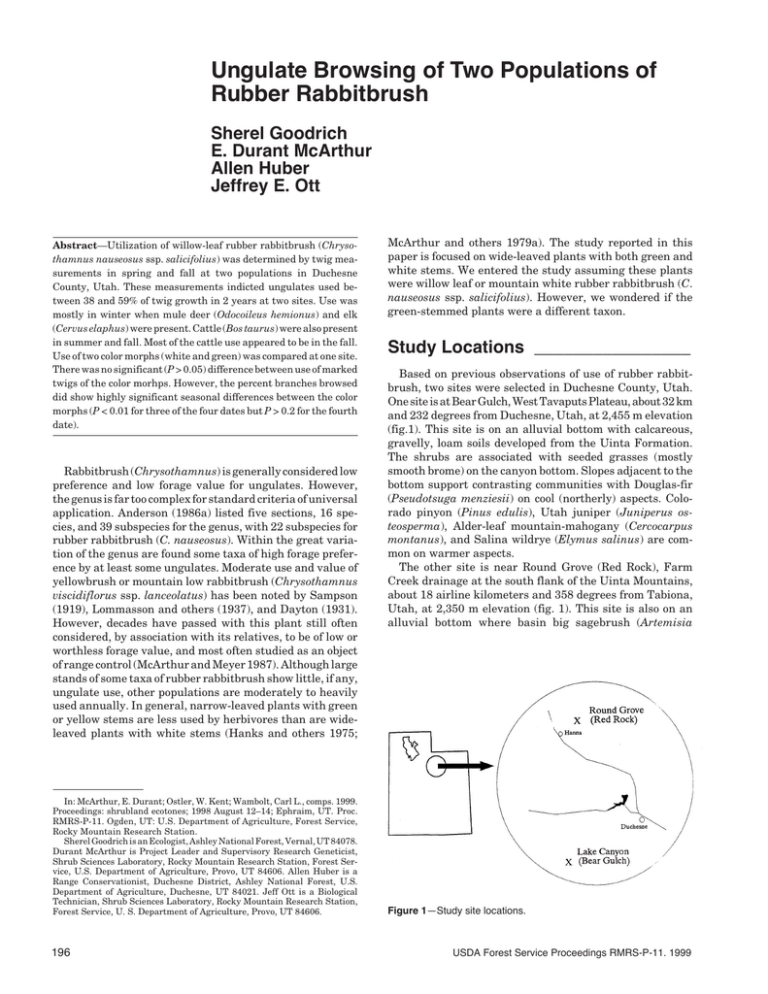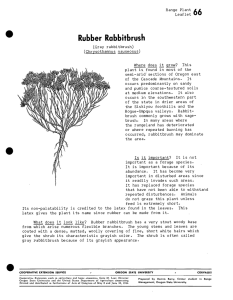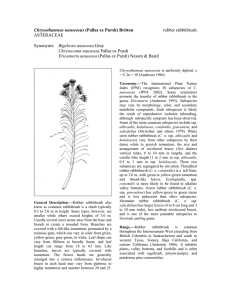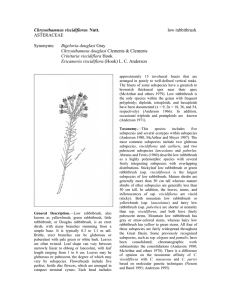Ungulate Browsing of Two Populations of Rubber Rabbitbrush Sherel Goodrich E. Durant McArthur
advertisement

Ungulate Browsing of Two Populations of Rubber Rabbitbrush Sherel Goodrich E. Durant McArthur Allen Huber Jeffrey E. Ott Abstract—Utilization of willow-leaf rubber rabbitbrush (Chrysothamnus nauseosus ssp. salicifolius) was determined by twig measurements in spring and fall at two populations in Duchesne County, Utah. These measurements indicted ungulates used between 38 and 59% of twig growth in 2 years at two sites. Use was mostly in winter when mule deer (Odocoileus hemionus) and elk (Cervus elaphus) were present. Cattle (Bos taurus) were also present in summer and fall. Most of the cattle use appeared to be in the fall. Use of two color morphs (white and green) was compared at one site. There was no significant (P > 0.05) difference between use of marked twigs of the color morhps. However, the percent branches browsed did show highly significant seasonal differences between the color morphs (P < 0.01 for three of the four dates but P > 0.2 for the fourth date). Rabbitbrush (Chrysothamnus) is generally considered low preference and low forage value for ungulates. However, the genus is far too complex for standard criteria of universal application. Anderson (1986a) listed five sections, 16 species, and 39 subspecies for the genus, with 22 subspecies for rubber rabbitbrush (C. nauseosus). Within the great variation of the genus are found some taxa of high forage preference by at least some ungulates. Moderate use and value of yellowbrush or mountain low rabbitbrush (Chrysothamnus viscidiflorus ssp. lanceolatus) has been noted by Sampson (1919), Lommasson and others (1937), and Dayton (1931). However, decades have passed with this plant still often considered, by association with its relatives, to be of low or worthless forage value, and most often studied as an object of range control (McArthur and Meyer 1987). Although large stands of some taxa of rubber rabbitbrush show little, if any, ungulate use, other populations are moderately to heavily used annually. In general, narrow-leaved plants with green or yellow stems are less used by herbivores than are wideleaved plants with white stems (Hanks and others 1975; In: McArthur, E. Durant; Ostler, W. Kent; Wambolt, Carl L., comps. 1999. Proceedings: shrubland ecotones; 1998 August 12–14; Ephraim, UT. Proc. RMRS-P-11. Ogden, UT: U.S. Department of Agriculture, Forest Service, Rocky Mountain Research Station. Sherel Goodrich is an Ecologist, Ashley National Forest, Vernal, UT 84078. Durant McArthur is Project Leader and Supervisory Research Geneticist, Shrub Sciences Laboratory, Rocky Mountain Research Station, Forest Service, U.S. Department of Agriculture, Provo, UT 84606. Allen Huber is a Range Conservationist, Duchesne District, Ashley National Forest, U.S. Department of Agriculture, Duchesne, UT 84021. Jeff Ott is a Biological Technician, Shrub Sciences Laboratory, Rocky Mountain Research Station, Forest Service, U. S. Department of Agriculture, Provo, UT 84606. 196 McArthur and others 1979a). The study reported in this paper is focused on wide-leaved plants with both green and white stems. We entered the study assuming these plants were willow leaf or mountain white rubber rabbitbrush (C. nauseosus ssp. salicifolius). However, we wondered if the green-stemmed plants were a different taxon. Study Locations ________________ Based on previous observations of use of rubber rabbitbrush, two sites were selected in Duchesne County, Utah. One site is at Bear Gulch, West Tavaputs Plateau, about 32 km and 232 degrees from Duchesne, Utah, at 2,455 m elevation (fig.1). This site is on an alluvial bottom with calcareous, gravelly, loam soils developed from the Uinta Formation. The shrubs are associated with seeded grasses (mostly smooth brome) on the canyon bottom. Slopes adjacent to the bottom support contrasting communities with Douglas-fir (Pseudotsuga menziesii) on cool (northerly) aspects. Colorado pinyon (Pinus edulis), Utah juniper (Juniperus osteosperma), Alder-leaf mountain-mahogany (Cercocarpus montanus), and Salina wildrye (Elymus salinus) are common on warmer aspects. The other site is near Round Grove (Red Rock), Farm Creek drainage at the south flank of the Uinta Mountains, about 18 airline kilometers and 358 degrees from Tabiona, Utah, at 2,350 m elevation (fig. 1). This site is also on an alluvial bottom where basin big sagebrush (Artemisia Figure 1—Study site locations. USDA Forest Service Proceedings RMRS-P-11. 1999 tridentata ssp. tridentata), snowberry (Symphoricarpos oreophilus), Kentucky bluegrass (Poa pratensis), and thickspike wheatgrass (Elymus lanceolatus) are common species. The adjacent uplands support an abundance of alder-leaf mountain-mahogany and other browse species. Methods _______________________ At the Bear Gulch site 10 rubber rabbitbrush plants were selected for study. For each plant, 12 branches were selected for measurements. Only unbrowsed twigs were selected in the fall of each year. Heavy plastic tape was used to mark a point on each selected twig below the point of anticipated browsing (fig. 2). Data were collected on four dates (22 Oct. 1991, 12 May 1992, 13 Oct. 1992, and 20 May 1993) so seasonal patterns of use and growth could be documented. Primary and secondary twigs were measured from the tape upward on each of these twigs in the fall after growth had stopped and in spring before initiation of growth for 2 years for a total of four readings. We recorded two primary branch measurements; the first one was total length of the branch distal to the stem and the second one (included in the first) was that portion of the branch between the tape and the first secondary branch. Secondary branches were only recorded if they were longer than 5 cm. Fecal group counts in three 1 by 50 m plots were made to give an indication of relative ungulate presence at the site (table 1). Fecal groups were swept from the plots after they were counted. At the Round Grove site 20 rubber rabbitbrush plants were selected with 10 plants having greenish stems and 10 plants having whitish stems. These plants were paired, e.g., each white-stemmed plant was paired systematically with a green-stemmed plant of similar size within a 2 meter radius. Branch measurements and pellet group counts were made as described above. Also 30 additional small branches per plant were observed for utilization. Branches were recorded as used if they had any obvious use by ungulates. Those with no obvious use were recorded as not used. Results are shown in table 2. Mean values that are followed with + indicate mean + standard error of the mean. To compare the white and green color morphs at Round Grove a paired t-test was performed (Woolf 1968). Percent values were arcsine transformed for data analysis but are reported herein as percent values. Figure 2—Sampling scheme for branch measurement. The 2nd primary branch (2nd 1°) was included in the regular primary measurement and is not discussed further in the study. Results ________________________ Contrast of branch length between fall and spring readings indicated about 55% use at the Bear Gulch site in both winters. This contrast indicated 59 and 36% use of the whitestemmed morph and 47 and 38% of the green-stemmed morph at Round Grove in the winters 1991-1992 and 19921993 respectively (tables 1, 2). Use of branches on individual Table 1—Ungulate fecal groups. Ungulate fecal groups Date Ungulate Total Round Grove Percent of total 05/92 Deer Elk Cow 9 0 0 100 0 0 0.060 0 0 10/92 Deer Elk Cow 4 0 25 14 0 86 0.027 0 0.167 1 18 34 2 34 64 0.007 0.120 0.227 05/93 Deer Elk Cow 6 18 2 23 69 8 0.040 0.120 0.013 0 29 1 0 97 3 0 0.123 0.007 USDA Forest Service Proceedings RMRS-P-11. 1999 Number per M2 Total Bear Gulch Percent of total Number per M2 197 Table 2—Paired t-tests for white and green morphs for ungulate use. Date 10/91 05/92 10/92 05/93 Percent of branches browsed (n = 30/plant) White Green 90.3 98.0 99.7 100.0 30.3 68.0 73.6 99.0 t 6.6 4.0 4.7 1.4 P <0.01 <0.01 <0.01 >0.20 shrubs varied from 34 to 72% at Bear Gulch and 18 to 80% for the white morph and from 6 to 92% for the green color morph at Round Grove (data not shown). The 30 twig comparisons of the white and green morphs at Round Grove were temporally different (table 2). White morphs ranged from 90-100%; green morphs from 30-90%. Fall readings showed greater use of the white morph than of the green one. Spring readings shows less difference in use between the 2 morphs than fall readings. Figure 3 documents the use and regrowth of primary and secondary branches of willowleaf rubber rabbitbrush at Bear Gulch and Red Rock (Round Grove). Note that primary branches are much longer (~2x) at Red Rock but the secondary branches (per primary branch) are much longer (~3x) at Bear Gulch. Discussion _____________________ Cattle were present in summer at the Round Grove site and in one summer at the Bear Gulch site. Cattle use of this shrub appeared to be quite limited except in the fall just before they were removed from the sites. Considerable cattle use of willow-leaf rubber rabbitbrush was observed in other canyons of the Tavaputs Plateau in the fall. Pellet group counts indicated most browsing of these shrubs at the Bear Gulch site was a function of elk use, and at Round Grove it was mostly a function of mule deer use in winter of 1991-1992 and elk and deer use in winter of 1992-1993 (table 3). We suspect the different growth forms at Bear Gulch and Round Grove are a result of more elk and cattle use on a sustained basis at Bear Gulch so the plant’s main central stem is harvested more frequently than at Round Grove. The mule deer at Round Grove apparently strip more secondary branches (fig. 3). At the Bear Gulch site, use was observed to take place as soon as wild ungulates moved on the area in late fall or early winter. Considerable use of this shrub occurred prior to or concurrent with use of alder-leaf mountain mahogany on adjacent slopes. Preference or selectivity equal to or greater than for alder-leaf mountain mahogany is indicated for this population. We have observed similar use of rubber rabbitbrush early in the winter season at Taylor Flat, Daggett County, where other browse species are available. This location in Daggett County was seeded with rubber rabbitbrush seed from a palatable population of C. nauseosus ssp. hololeucus from Salt Creek, Juab County, Utah. The two color morphs at Round Grove are apparently both willow-leaf rubber rabbitbrush. Subspecies of rubber rabbitbrush are often sympatric (McArthur and others 1979b; Anderson 1986b) but in this case the two morphs behave quite similarly and are eaten by ungulates much the same. The stems of the green morph are light green and not as dark as many rubber rabbitbrush subspecies. The difference in stem color and temporal difference in twig end browsing (total stem browsing was not different) may be due to a small genetic difference within the population. Readings in the fall showed considerably higher use of twigs of the white morph than for the green one. However, by spring the difference was smaller. This indicates preference for the white morph and acceptance of the green morph as preferred forage had evened out during the winter. Early use of preferred plants and delayed acceptance of less preferred plants as winter progresses seems reasonable. Such a relationship has been noted by Welch and others (1981) and Hutchings and Stewart (1953) for ungulates and by Welch and others (1991) for sage grouse. This relationship is not reflected in our branch utilization measurements that compare growth with utilization at the end of winter. Had measurements been taken to compare late fall or early winter use, branch utilization data might have reflected preference for the white morph. In addition to rubber rabbitbrush use, we observed use of yellowbrush at the Bear Gulch and Round Grove sites where it was moderately to closely hedged after each winter browsing season. Table 3—Summary of branch lengths and percent Use. Date 10/91 10/92 5/93 BearGulch Branch length (cm) Percent usea 16,404 — 7,522 55.5 ± 4.3 11,925 — 5,255 54.5 ± 2.8 Red Rock (Round Grove) White morph Branch length (cm) Percent usea 5,604 — 2,178 59.0 ± 5.4 5,736 — 3,240 36.4 ± 5.2 Green morph Branch length (cm) Percent usea 5,511 — 2,686 47.4 ± 8.1 6,007 — 3,780 38.5 ± 2.7 a 198 5/92 Based on individual samples, 10 plants per population and 12 branches per plant. USDA Forest Service Proceedings RMRS-P-11. 1999 Figure 3—Branch lengths over the course of the study. Left—Bear Gulch, Right—Red Rock (Round Grove). Apparently by association with large stands of unpalatable rabbitbrush, all rabbitbrush is sometimes considered of no forage value or at best of low value. This complex of plants is far too variable to fit such a simplified standard criteria. In addition to selectivity demonstrated by some ungulates at least at some times of the year, nutritional value is indicated to be high. In a study of seven subspecies of rubber rabbitbrush, Bhat and others (1990) found crude protein levels about equal to that of other high-protein shrubs such as big sagebrush and fourwing saltbush. Protein levels found in this study exceeded protein requirements of wintering mule deer and sheep of about 7.5-8.9% (Welch 1989). On the Wyoming Red Desert, crude protein values of 9.7 and 6.8% were found for summer and winter, respectively (Krysl and others 1984). Phosphorus levels and in vitro dry matter digestion also rated high compared to some other winter browse species (Bhat and others 1990). Complexity of this group of plants as well as rangelands in general demonstrate the need to go beyond simplified standard criteria designed for universal application. Observations passed on from one generation to the next without critical review has greatly suppressed the understanding and use of valuable resources to be found in the rabbitbrush complex. References _____________________ Anderson, L. C. 1986a. An overview of the genus Chrysothamnus Asteraceae. In: McArthur, E. D.; Welch, B. L., comps. Proceedings—symposium on the biology of Artemisia and Chrysothamnus; 1984 July 9-13; Provo, UT. Gen. Tech. Rep. INT-200. Ogden, UT: U.S. Department of Agriculture, Forest Service, Intermountain Research Station: 29-45. Anderson, L. C. 1986b. Sympatric subspecies in Chrysothamnus nauseosus. In: McArthur, E. D.; Welch, B. L., comps. Proceedings—symposium on the biology of Artemisia and Chrysothamnus; 1984 July 9-13; Provo, UT. Gen. Tech. Rep. INT-200. Ogden, UT: U.S. Department of Agriculture, Forest Service, Intermountain Research Station: 98-103. USDA Forest Service Proceedings RMRS-P-11. 1999 Bhat, R. B.; Welsh, B. L.; Weber, D. J.; McArthur, E. D. 1990. Midwinter protein, phosphorus, and digestibility of Chrysothamnus nauseosus subspecies. Journal of Range Management. 43: 177-179. Dayton, W. A. 1931. Important western browse plants. Misc. Pub. 101. Washington, DC: U.S. Department of Agriculture. 214 p. Hanks, D. L.; McArthur, E. D.; Plummer, A. P.; Giunta, B. C.; Blawer, A. C. 1975. Chromatographic recognition of some palatable and unpalatable subspecies of rubber rabbitbrush in and around Utah. Journal of Range Management. 28: 144-148. Hutchings, S. S.; Stewart, G. 1953. Increasing forage yields and sheep production on Intermountain winter ranges. Circular No. 925. Washington DC: U.S. department of Agriculture, Forest Service. 63 p. Krysl, L. J.; Sowell, B. F.; Hubbert, M. E.; Plumb, G. E. et al. 1984. Horses and cattle grazing in the Wyoming Red Desert, II. dietary quality. Journal of Range Management. 37: 252-256. Lommasson, T.; Park, B. C.; Kutzleb, C. A. and others. 1937. Range plant handbook. Washington, DC: U.S. Department of Agriculture. McArthur, E. D.; Blauer, A. C.; Plummer, A. P.; Stevens, R. 1979a. Characteristics and hybridization of important Intermountain shrubs III. INT-RP-220. Ogden, UT: U.S. Department of Agriculture, Forest Service, Intermountain Forest and Range Experiment Station. 82 p. McArthur E. D.; Tiernan, C. F.; Welch, B. L. 1979b. Subspecies specificity of gall forms on Chrysothamnus nauseosus. Great Basin Naturalist. 39: 81-87. McArthur, E. D.; Meyer, S. E. 1987. A review of the taxonomy and distribution of Chrysothamnus. In: Johnson, K. L. Proceedings of the Fourth Utah Shrub Ecology Workshop, the genus Chrysothamnus; 1986 September 17-18; Cedar City UT. Logan, UT: Utah State University, College of Natural Resources: 9-17. Sampson, A. W. 1919. Plant succession in relation to range management. U.S. Department of Agriculture Bull. 791. Washington, DC: U. S. Department of Agriculture. 76 p. Welch, B. L. 1989. Nutritive value of shrubs. In: McKell, C. M., ed. The biology and utilization of shrubs. San Diego: Academic Press Inc.: 405-424. Welch, B. L.; McArthur, E. D.; Davis, J. N. 1981. Differential preference of wintering mule deer for accessions of big sagebrush and for black sagebrush. Journal of Range Management. 34: 409-411. Welch, B. L.; Wagstaff, F. J.; Roberson, J. A. 1991. Preference of wintering sage grouse for big sagebrush. Journal of Range Management. 44: 462-465. Woolf, C. M. 1968. Principles of Biometry. Princeton, NJ: D. Van Nostrant Co., Inc. 359 p. 199









